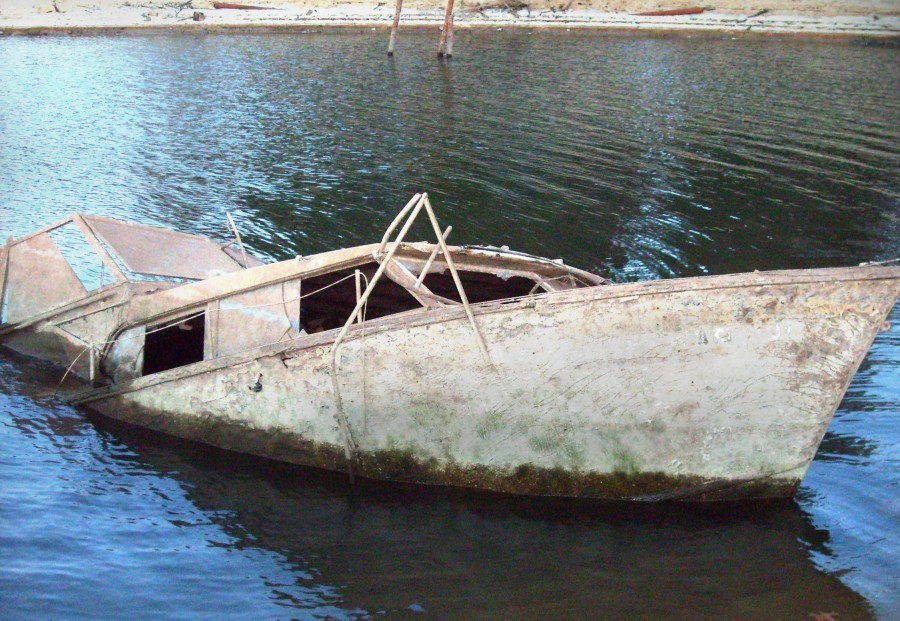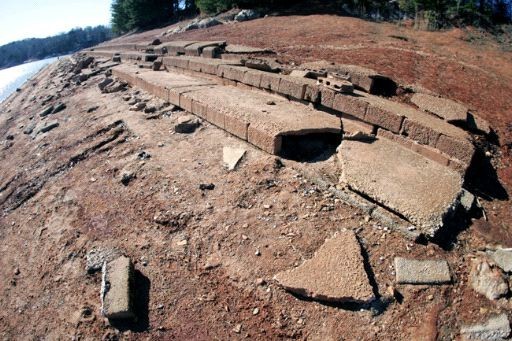GAINESVILLE -- The acres of drying mud that span much of what once was Lake Lanier jolt to a stop at a bend, where a concrete foundation suddenly appears.
The neatly placed blocks seem out of place, but they're a reminder of life before the lake.
As a record drought continues to take its toll on the 38,000-acre man-made reservoir that supplies more than 3 million residents with water in metro Atlanta and north Georgia, the receding shore line is revealing more than antique beer cans and other assorted garbage.
It is also offering a glimpse of how the people who made their homes here decades ago once lived.
An abandoned stretch of Georgia Highway 53 sits along one edge of the lake, consigned to the deep by state planners when Lanier was built. Foundations of long-forgotten buildings dot some shorelines. Elsewhere in the vast expanse of exposed lake bed, a still intact one-lane road with faded yellow lines peeks out from the mud.
Outside Gainesville's Laurel Park, the concrete foundation is a remnant of what once was the Gainesville Speedway, a popular dirt racing track that was submerged when the federal government created the lake in the 1950s.
Some 700 families were moved then to make way for the new reservoir. Contractors demolished homes, farms and other building to clear the way for the construction of the Buford Dam.
Now, after being hidden for decades, the places they left behind - and everything from boat batteries to entire sunken boats - are in sight again as the shore continues to recede. The volume of debris that's turned up alongside the old landmarks has distressed many of the lake's more recent settlers.
"It's horrendous. It's unbelievable," said Vicki Barnhorst, executive director of the Lake Lanier Association. "A lot is being exposed."
Community groups have organized cleanup expeditions to gather the trash and debris suddenly revealed by the falling lake levels.
Barnhorst's group, for one, is organizing "shore sweeps" and asking residents and tourists to stash the trash found along the lake bed in nearby trash bins.
"We've found anything that can be thrown off a boat: Lawn chairs, anchors, ladders, boats themselves," she said. "In a way it's interesting, I guess. But I feel really heartbroken for the lake. If there's a silver lining, it's being able to get the trash out."
A few sunken cars - some of them stolen - have seen the light of day as the water level dropped. But Georgia Bureau of Investigation spokesman John Bankhead said he's not aware of any cases solved with evidence recovered from the drying lake. Ditto for officials in counties that hug Lanier's shore.
"We've recovered a few stolen cars and a couple of stolen firearms," said Maj. Jeff Strickland of the Hall County Sheriff's Department. "But nothing linked to any crimes."
Added Capt. Frank Huggins of the Forsyth County Sheriff's Department: "I wish it had. We found one car, but it didn't turn out to be stolen. We don't really know why it's there."
Although the professional sleuths haven't had much luck, Lanier's dropping water level - now about 19 feet below normal and counting - has inspired a sort of amateur archaeology.
On a recent afternoon, Mark Parrott and two friends walked around a newly revealed peninsula, speculating about what each remnant could have been.
The cement blocks on one side of the muddy splotch of land could have marked a farmhouse, Parrott figured. And fragments of a horseshoe may be a sign that a stable once stood nearby.
"It's been under water for so long," he said, shaking his head.
And Parrott discovered another advantage - though not a particularly sporting one - to the dwindling lake level.
He and his friends set up 10 fishing poles along the edge of the peninsula. Within hours, the group had caught a catfish and a few 10-pound stripers.
"Less water," he said, as a grin crept across his face, "means less places for the fish to hide."
---
On the Net:
http://www.drought.gov
Saturday
March 1st, 2025
7:13AM




















